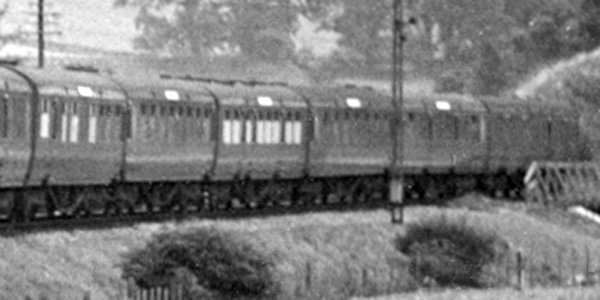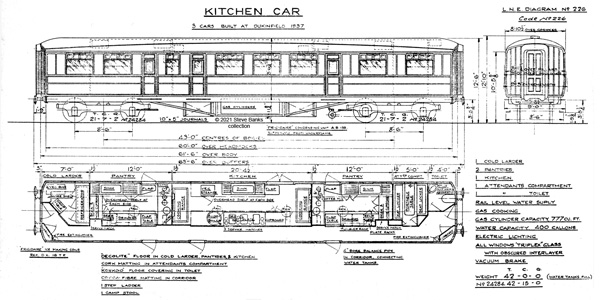Thompson Kitchen and Dining Cars
Thompson abandoned articulation for the three-car catering sets (FO-RK-TO) and provided independent carriages to the same format (FO,RK,TO). They were built to the new length of 63'0" between 1947-49 (although the dates quoted by Michael Harris don't quite tally with the photographs, construction of the dining cars definitely having started in 1947). Six more of each dining car were built than were intended to serve with kitchen cars - the extra ones could be paired with an RF or RT, although Thompson only produced the former.
New additions placed here temporarily

As far as I can tell, this blank-back picture was taken at Doncaster and shows A1 No 60125 Scottish Union in the middle of the afternoon with the Up "Flying Scotsman". The formation tallies with the roster for 1953(s) when most of the train was made up with BR Mk.1 coaches - except for Thompson catering. Photo: author's collection.
Confirmation
I can confirm this now after checking the sun angle (which gives approximately 3pm) and the 1953 WTT (which shows the Up "Flying Scotsman" passing through Doncaster at 2.33pm SX and 3.9pm SO, which suggests the picture was taken on a Saturday, as was the case for an overwhelming number of pictures by amateur photographers, a bias that I've mentioned before).
It's also possible to rule out the next train, which was the 10.10am from Edinburgh (sometimes called the "Junior Scotsman") which passed through Doncaster about twenty minutes later and, most tellingly, was rostered for less refined catering: (RF,TO)
All this would have been straightforward had the train nameboard been carried by the loco but there were many times when a nameboard was not affixed, on this express and others, of course.
Click on the image for an enlargement

This enlargement has been sharpened, which is a mixed blessing because sharpening you don't actually get! However, viewers with eagle eyes should be able to see the Thompson 3-car catering:
FO |
1st open (dining) |
RK |
kitchen car |
TO |
3rd open (dining) |
It looks like the FO has been updated with the BR carmine & cream livery but the other two are still carrying simulated teak livery. The RK is seen from the kitchen side. As an aside, the FO had 42 seats but only 30 were laid for meals. This sort of thing was quite common with FO and TO dining cars and helps explain why, in LNER days, pre-Group FOs with 36 seats stayed in service, in a similar fashion, only perhaps 24 seats being allocated for catering.
Further back in the 3rd class part of the train another Thompson (a TK) can be seen still in simulated varnished teak but I can't say if this was a remnant awaiting modernisation or a substitute for failure of a BR Mk.1 - both are feasible.
Thompson Kitchen and Dining Cars
The carriages

The layout of the 1st Open to D.351 was conventional although the leg room was increased by an inch from 7'3" to 7'4". The lavatory was made significantly longer and less cramped, from just over 4ft to 4'10". The first three were fitted with pressure ventilation for use with the new "Flying Scotsman" (one in each train and one as a spare). Construction of 17 carried running numbers of: 1956-58 (PV) 1959-72
Diagram: author's collection.
Click on the image for an enlargement

An ex-works picture taken using orthochromatic film which presented red tones as almost black, hence the beautifully applied teak finish cannot be seen and should not be confused with reflections of the track. No 1958 was one of the first three built with pressure ventilation. Photo: BR, author's collection.
Click on the image for an enlargement

Another picture taken using orthochromatic film showing No E1959 was taken in 1949 and it has round corners to the windows. As this was built immediately after No 1958 above and was the 4th out of 17, the implication is that most of these carriages had round corners.
Simulated teak was still being applied but the lettering was BR-style in pale yellow. Photo: Author's collection.
Click on the image for an enlargement

Diagram 353 for the new kitchen cars shows how the new length of 63ft was exploited with a huge kitchen and two pantries. Cooking was anthracite-electric. On the far left in a separate compartment, the cold larder contained a refrigerator, ice cream cabinet and 4 vegetable bins. Its exterior window was not glazed but fitted with a ventilating grille.
11 were built including three with pressure ventilation and numbered: 1943-45 (PV) 1946-53
Diagram: author's collection.
Click on the image for an enlargement

The 3rd Open Dining Car to D.350 followed established practice although the leg room was increased more significantly by almost four inches, from 6'2" to 6'5 1/2". The lavatory was also made longer, same as in the FO. 17 were built with running numbers of: 1982-84 (PV) 1985-98
Diagram: author's collection.
Click on the image for an enlargement

Yet another picture taken with orthochromatic film which presented red tones as almost black, hence the beautifully applied teak finish cannot be seen - don't be misled by reflections of the track and snow! This is carriage No 1984, one of the three built in 1947 and fitted with pressure ventilation for the "Flying Scotsman". Photo: BR, author's collection.
Click on the image for an enlargement
In service

Haymarket's A4 No 60031 Golden Plover heads north with "The Capitals Limited" at Grantshouse in 1949 with Thompson carriages from end to end and the catering trio near the King's Cross buffers end. Photo: E.R. Wethersett

An enlargement of the catering trio at the far end of the train is useful albeit not too sharp. The kitchen car is seen from the corridor side, same as shown on the Diagram. Photo: E.R. Wethersett

A2 No 60538 Velocity is captured on the ECML near Naburn in early BR, apple-green livery with an unidentified 13-coach express made up almost entirely with recently-built Thompson carriages with solebar fairing (a single Gresley has been added in the middle). The 1st class end is behind the tender with the catering trio clear to see. Author's collection.
Click on the image for an enlargement

An enlargement of of the catering coaches (FO,RK,TO) with apologies for the poor sharpness. The kitchen car is again seen from the corridor side, as shown on the Diagram.

Seen in the early 1950s at York, Peppercorn A1 No 60115 Meg Merrilies (a Newcastle loco at the time) eases the "Flying Scotsman" into York. The carriages are a mixture of ex-LNER and BR Mk.1 in simulated teak and BR livery, with a recently built 1st behind the all-steel BG. Standing out is a freshly repainted Thompson Kitchen Car flanked by its FO and TO. This time the other side is seen with the cold larder and its grilled window nearest the camera.
None of the Thompson carriages in view is carrying the solebar fairing. It's hard to tell but I think the kitchen car is branded BR-style "KITCHEN CAR". The all-steel BG behind the tender with its customary destination board is a little harder to resolve. Its running number can be made out - E173E - with the suffix "E" brighter as if if recently added. The body may still have been carrying simulated teak but BR crimson is more plausible. Author's collection.
Click on the image for an enlargement

York's V2 No 60886 in May 1964 departs Sunderland with a parcels train. Placed at the head of a SR 4w utility van, a BR Mk.1 BG and various other vans are two ex-LNER catering carriages, kitchen cars, no less - as an ECS movement. I've made the point before that parcels trains routinely carried empty vans as well as any passenger carriages needing to be moved. Colour-Rail BRE1092.
Click on the image for an enlargement

A detail view of the two RKs.
Thompson 63' RK - the later steel-panelled design used as a modern version of three car catering in ECML expresses with the roof fittings showing rather well. It's seen from the corridor side, same as the drawing on the Diagram, see below.
Gresley 61'6" RK - this one's not quite so clear and shows the teak version of the late 1930s which was built for use with top-end excursions containing 3rd Open carriages in which meals could be served. In the first three (1937) the cooking was by gas but in a fourth one added in 1939, it was anthracite-electric. It's not possible to tell which here. The small-windowed staff side can be seen. I described construction of both Gresley versions in quite a big article in MRJ with pictures of the prototypes and assembling the models (see Articles Index).
Click on the image for an enlargement
Here for direct comparison are Thompson and Gresley kitchen cars:

Details above. Diagram: author's collection. Click on the image for an enlargement

It doesn't really belong in this section but here's the Diagram of the Gresley 61'6" RK. This is D.226, with gas cooking. Diagram author's collection.
Click on the image for an enlargement


